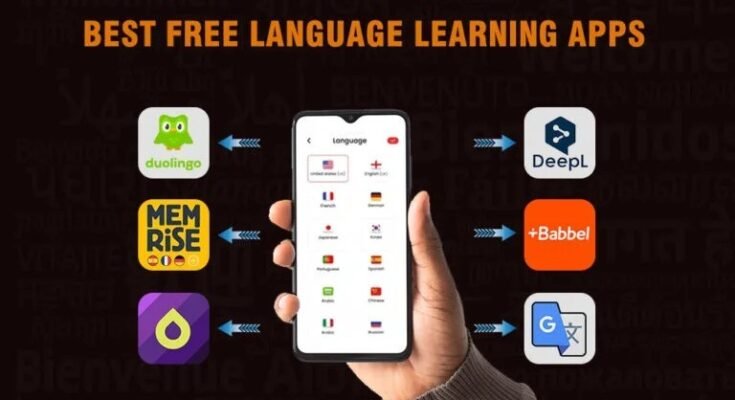In our increasingly globalized world, the ability to speak multiple languages is no longer a luxury — it’s becoming essential. Whether for travel, work, or simply personal growth, language learning has never been more important. But let’s face it, mastering a new language can be tough. That’s where language learning apps come in, making the process easier, faster, and even fun! 🎉
As we look ahead to 2025, these apps are evolving beyond what we’ve known so far, powered by the latest tech, artificial intelligence (AI), and innovative teaching methods. In this article, we’ll dive deep into the world of language learning apps in 2025 — what’s new, what works, and how you can make the most of them to become fluent faster than ever! 🚀
Why Language Learning Apps Are Exploding in Popularity 📈
First, let’s talk about why so many people are turning to apps for learning languages.
- Convenience: Apps allow you to practice anytime, anywhere. Waiting for a bus? Open the app. Lunch break? Practice a lesson. No need for fixed schedules or physical classrooms. ⏰
- Affordable: Compared to traditional classes or private tutors, apps are usually much cheaper, and many have free versions! 💸
- Personalized Learning: Modern apps use AI to tailor lessons to your pace and style. No more one-size-fits-all teaching. 🎯
- Interactive & Fun: Gamified lessons, quizzes, and challenges keep motivation high. You actually look forward to learning! 🎮
- Global Community: Many apps offer social features to practice with native speakers and other learners worldwide. 🌐
As of 2025, these factors have made language apps a top choice for millions of learners globally, across ages and professions.
The Tech Behind Language Learning Apps in 2025 🤖
The big question: what’s changed from the apps you may have tried before? The answer: technology and data-driven personalization.
1. Artificial Intelligence (AI) and Machine Learning
AI has revolutionized language learning by creating highly adaptive programs. For example:
- Speech recognition technology now understands accents better than ever, giving you precise feedback on pronunciation.
- AI tutors simulate conversations and respond naturally, so you can practice dialogue without feeling robotic.
- Smart content generation: The app learns your weaknesses and automatically creates exercises to target those areas.
2. Augmented Reality (AR) and Virtual Reality (VR)
Imagine putting on your VR headset and stepping into a bustling Paris street where you have to order croissants in French, or using AR on your phone to label objects in your surroundings with their names in Spanish. This is not sci-fi — it’s happening now and will be mainstream in 2025! 🥐🇫🇷
3. Natural Language Processing (NLP)
NLP powers apps to understand not just what you say, but how you say it, helping with grammar, context, and cultural nuances — the kind of things textbooks can’t teach well. This means more realistic conversations and better comprehension.
4. Data Analytics
Behind the scenes, apps gather anonymous data to figure out which methods work best and constantly improve your learning path based on what millions of users do worldwide.
Top Features to Expect in Language Apps by 2025 🏆
Here’s what a cutting-edge language learning app will look like in 2025:
Personalized Learning Paths 🛤️
No more generic lessons! Apps analyze your starting level, goals, and learning style to create a custom plan — whether you want casual travel phrases or advanced business language. The plan adapts in real-time based on your progress.
Real-Life Conversation Practice 🗣️
Using AI chatbots and VR environments, you’ll practice with virtual natives who respond naturally, helping you gain confidence without fear of mistakes.
Instant Pronunciation Feedback 🔊
Thanks to better speech recognition, you get instant, detailed tips on how to tweak your accent and intonation, helping you sound more natural.
Cultural Insights 🌐
Language is tied to culture. The best apps include mini-lessons on customs, etiquette, and slang to avoid embarrassing mistakes and help you connect deeply with native speakers.
Gamification & Social Features 🎲👥
Leaderboards, badges, group challenges, and native-speaker chats keep you motivated and engaged. Learning together is more fun!
Offline Mode 🌴
You can download lessons and practice without internet — perfect for flights or remote areas.
The Best Language Learning Apps You’ll Use in 2025 🔥
Let’s talk about some apps that are shaping up to dominate the language learning world by 2025.
1. Duolingo: The Evergreen Favorite 🦉
Duolingo has been a leader for years, and it keeps innovating with AI-driven adaptive learning and mini VR scenarios. It’s free to start, making it great for beginners and casual learners.
2. Babbel: For Practical Conversational Skills 💬
Babbel focuses on real-life conversation and grammar, with lessons designed by linguists. Its AR feature for object labeling is becoming a game-changer.
3. Rosetta Stone: The Immersive Experience 🌎
Known for its immersive approach, Rosetta Stone has integrated VR lessons where you can simulate traveling and interacting in the target language’s country.
4. Memrise: For Vocabulary & Culture 🎭
Memrise combines memory science with cultural clips from native speakers, plus AI chatbots for practice. Its community-driven content keeps expanding.
5. HelloTalk: Speak With Natives Instantly 🗺️
HelloTalk is a social app connecting you with native speakers worldwide for free language exchange via text, voice, and video chats.
How to Maximize Your Language Learning in 2025 💡
Having access to advanced apps is great, but success depends on how you use them. Here are some tips to get fluent faster:
1. Set Clear Goals 🎯
Decide what you want — traveling, business, casual chatting — and pick an app or features that fit those goals.
2. Practice Daily, Even if Just 10 Minutes ⏳
Consistency beats cramming. Short, regular sessions keep your brain engaged and memory sharp.
3. Use Multiple Tools Together 🔄
Combine apps — for example, Duolingo for basics, HelloTalk for speaking practice, and Memrise for vocab building.
4. Immerse Yourself Outside the App 🌍
Listen to podcasts, watch movies, or read articles in your target language. This reinforces what you learn.
5. Don’t Fear Mistakes! ❌
Speaking imperfectly is part of learning. Use app feedback to improve, but don’t hesitate to try real conversations.
The Challenges Still Ahead 🚧
Even with all this tech, language learning apps face hurdles:
- Maintaining motivation: Apps can’t force discipline; learners must stay committed.
- Nuances of culture: While improving, apps still struggle to teach deep cultural context perfectly.
- Access & affordability: In some parts of the world, high-end tech might still be out of reach.
Looking Beyond 2025: What’s Next? 🔮
The future is bright and full of possibilities:
- Brain-Computer Interfaces: Imagine learning vocabulary simply by thinking about it — direct brain uploads!
- Hyper-personalized AI tutors: Fully human-like tutors who know your personality, mood, and learning quirks.
- Cross-language AI translation: Speak your native language, and AI translates in real-time for fluent, natural conversations with anyone.
Final Thoughts 💭
Language learning apps in 2025 are more than just study tools — they’re your personal coaches, cultural guides, and conversation partners wrapped in one. Whether you’re learning Spanish for a vacation, Mandarin for business, or just exploring for fun, the tech available makes fluency more accessible and enjoyable than ever.
So, why wait? Start your language learning journey today and watch yourself grow into a confident, global citizen! 🌟🌏




